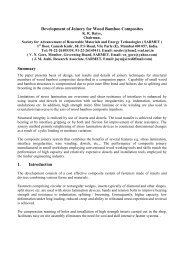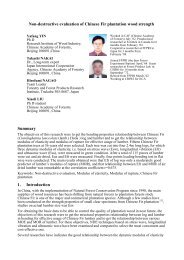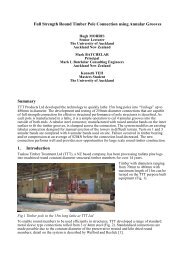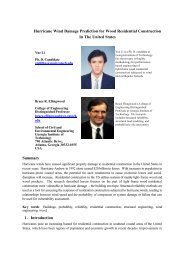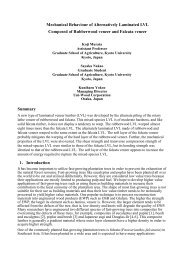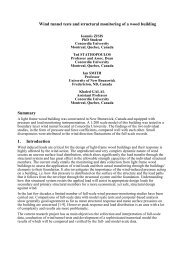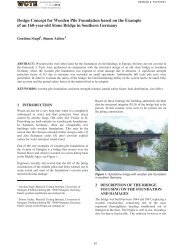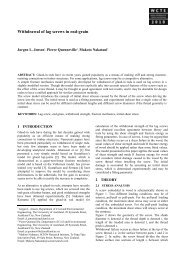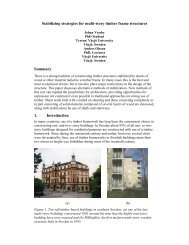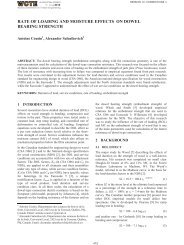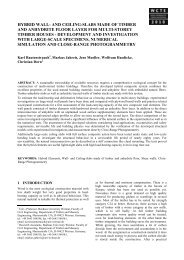Use of Dense Hardwood in Engineered Wood Product ...
Use of Dense Hardwood in Engineered Wood Product ...
Use of Dense Hardwood in Engineered Wood Product ...
You also want an ePaper? Increase the reach of your titles
YUMPU automatically turns print PDFs into web optimized ePapers that Google loves.
Summary<br />
<strong>Use</strong> <strong>of</strong> <strong>Dense</strong> <strong>Hardwood</strong> <strong>in</strong> Eng<strong>in</strong>eered <strong>Wood</strong> <strong>Product</strong> Manufactur<strong>in</strong>g<br />
Stephen Delahunty<br />
Graduate Research Assistant<br />
Faculty <strong>of</strong> Forestry and Environmental Management, University <strong>of</strong> New Brunswick<br />
Fredericton, New Brunswick, Canada<br />
Y<strong>in</strong>g H. Chui<br />
Pr<strong>of</strong>essor<br />
Faculty <strong>of</strong> Forestry and Environmental Management, University <strong>of</strong> New Brunswick<br />
Fredericton, New Brunswick, Canada<br />
There is an apparent world-wide trend to utilize hardwood <strong>in</strong> produc<strong>in</strong>g eng<strong>in</strong>eered wood products<br />
(EWP). <strong>Dense</strong> hardwood lumber provides a better potential for produc<strong>in</strong>g high strength EWP than<br />
s<strong>of</strong>twood lumber. A procedure to evaluate the economics <strong>of</strong> us<strong>in</strong>g a new hardwood source material<br />
<strong>in</strong> EWPs that considers lumber quality is presented. The mechanical property used here to<br />
characterize lumber quality is modulus <strong>of</strong> elasticity. This procedure is demonstrated us<strong>in</strong>g a case<br />
study <strong>in</strong> which red maple lumber was used as flange stock and lam<strong>in</strong>ates to produce predeterm<strong>in</strong>ed<br />
I-joist and glulam beams.<br />
1. Introduction<br />
The eng<strong>in</strong>eered wood product (EWP) <strong>in</strong>dustry <strong>in</strong> North America has experienced exceptional<br />
growth <strong>in</strong> recent years. Currently, virtually all lumber based EWPs are made from high quality<br />
s<strong>of</strong>twood dimension lumber. This is despite the fact that hardwood lumber generally possesses<br />
better mechanical properties than s<strong>of</strong>twood lumber, which <strong>in</strong> theory should make hardwood lumber<br />
a more suitable material than s<strong>of</strong>twood lumber <strong>in</strong> EWP applications. <strong>Hardwood</strong> lumber has<br />
traditionally been used <strong>in</strong> mak<strong>in</strong>g appearance products and its use <strong>in</strong> structural applications has been<br />
limited. One exception is the use <strong>of</strong> aspen/poplar <strong>in</strong> manufactur<strong>in</strong>g oriented strandboard. The<br />
fabrication <strong>of</strong> structural wood members us<strong>in</strong>g hardwood components has recently attracted the<br />
attention <strong>of</strong> research organizations and <strong>in</strong>dustry <strong>in</strong> North America and Europe. In Europe extensive<br />
research on utiliz<strong>in</strong>g birch (Solli 2004) and beech (Glos et al 2004) <strong>in</strong> manufactur<strong>in</strong>g glulam has<br />
been conducted. The United States Forest <strong>Product</strong>s Laboratory undertook a number <strong>of</strong> studies to<br />
evaluate the use <strong>of</strong> hardwood species as dimension lumber (McDonald et al 1993, Green and<br />
McDonald 1993), and as glued lam<strong>in</strong>ated timber (glulam) (Manbeck et al 1993, Moody et al 1993,<br />
Janowiak et al 1995). In the United States, hardwood glulam products are covered <strong>in</strong> the American<br />
Institute <strong>of</strong> Timber Construction (AITC) standard (AITC 1996) however specifications for<br />
hardwoods are lack<strong>in</strong>g <strong>in</strong> the correspond<strong>in</strong>g Canadian products and design standards. A Canadian<br />
wood products research <strong>in</strong>stitute, For<strong>in</strong>tek Canada Corp, evaluated a structural lam<strong>in</strong>ated product<br />
concept <strong>of</strong> comb<strong>in</strong><strong>in</strong>g low-grade white birch lumber as face lam<strong>in</strong>ates and balsam fir as core<br />
lam<strong>in</strong>ates (Blanchet 2003).<br />
The majority <strong>of</strong> lumber based EWPs produced <strong>in</strong> eastern Canada are made us<strong>in</strong>g lumber sawn from<br />
dense black spruce trees that grow <strong>in</strong> northern Quebec. The slow growth rate <strong>of</strong> these trees, along<br />
with the presence <strong>of</strong> small encased knots, makes the result<strong>in</strong>g lumber ideal for structural<br />
applications. There is, however, a grow<strong>in</strong>g raw material supply shortage concern <strong>in</strong> eastern Canada<br />
ma<strong>in</strong>ly due to the outstand<strong>in</strong>g <strong>in</strong>crease <strong>in</strong> production <strong>of</strong> EWPs <strong>in</strong> the recent past.<br />
This paper expla<strong>in</strong>s a procedure that was developed to evaluate the economics <strong>of</strong> <strong>in</strong>troduc<strong>in</strong>g a new<br />
hardwood source material for EWPs tak<strong>in</strong>g <strong>in</strong>to consideration lumber quality so that the total value
<strong>of</strong> each log can be maximized. Although this procedure is primarily based on model<strong>in</strong>g this paper<br />
focuses on the characterization <strong>of</strong> lumber quality which is expressed here <strong>in</strong> terms <strong>of</strong> modulus <strong>of</strong><br />
elasticity (MOE). The overall procedure provides a l<strong>in</strong>k between logs sawn <strong>in</strong>to lumber, and lumber<br />
manufactured <strong>in</strong>to EWPs. A series <strong>of</strong> lumber yield predictions are developed and <strong>in</strong>corporated <strong>in</strong>to<br />
a simulation model which uses Monte Carlo sampl<strong>in</strong>g techniques to model the variability <strong>in</strong> lumber<br />
yield and lumber quality. The output from the simulation model, the <strong>in</strong>ventory <strong>of</strong> mechanically<br />
graded E-rated lumber available to produce EWPs, is transferred to an optimization model designed<br />
to maximize the total revenue result<strong>in</strong>g from the sale <strong>of</strong> the f<strong>in</strong>ished EWPs. A case study <strong>in</strong> which<br />
red maple was used <strong>in</strong> the production <strong>of</strong> wood I-joists and glulam is described to demonstrate the<br />
lumber quality component <strong>of</strong> this procedure.<br />
2. Procedure<br />
Approximately 300 red maple sawlogs were obta<strong>in</strong>ed and geometric log characteristic data was<br />
collected. This log data was fitted to probability distributions to simulate the variation <strong>of</strong> log<br />
geometry. The log geometry values assigned by the model are used to determ<strong>in</strong>e lumber yields. The<br />
logs were divided <strong>in</strong>to two groups with one group processed <strong>in</strong>to 38mm x 64mm lumber to be used<br />
as flanges for I-joists and the other group processed <strong>in</strong>to 38mm 89mm lumber to be used as<br />
lam<strong>in</strong>ates for glulam beams. All lumber was then dried to a target moisture content <strong>of</strong> 15 percent<br />
(oven-dried basis) and planed to the proper f<strong>in</strong>ished dimension. A sample <strong>of</strong> lumber (n = 32) was<br />
selected us<strong>in</strong>g a stratified sampl<strong>in</strong>g method so that the top diameter <strong>of</strong> the logs would be<br />
proportionately represented. The lumber MOE was measured accord<strong>in</strong>g to ASTM D198 test<br />
procedure (ASTM 2004). The same sample <strong>of</strong> lumber were then passed through a two pass constant<br />
deflection Cook-Bol<strong>in</strong>der mach<strong>in</strong>e to measure the apparent MOE, termed Emean. S<strong>in</strong>ce lumber is<br />
heterogeneous, MOE depends on span, orientation (edgewise or flatwise <strong>in</strong> bend<strong>in</strong>g), load speed <strong>of</strong><br />
test (static or dynamic) and method <strong>of</strong> load<strong>in</strong>g (tension, bend<strong>in</strong>g, concentrated or uniform) (Green<br />
and Kretschmann 1991). The static bend<strong>in</strong>g test for MOE outl<strong>in</strong>ed <strong>in</strong> ASTM D198 was used here as<br />
a basel<strong>in</strong>e measure <strong>of</strong> the true MOE.<br />
MOE (MPa)<br />
20000<br />
18000<br />
16000<br />
14000<br />
12000<br />
10000<br />
8000<br />
6000<br />
4000<br />
2000<br />
0<br />
R 2 = 0.74<br />
9000 11000 13000 15000 17000 19000 21000<br />
Emean (MPa)<br />
Figure 1 Correlation between MOE and Emean<br />
Figure 1 is a l<strong>in</strong>ear regression analysis<br />
us<strong>in</strong>g Emean as an <strong>in</strong>dicator <strong>of</strong> MOE and<br />
equation [1] describes the result<strong>in</strong>g l<strong>in</strong>e<br />
<strong>of</strong> best fit. F<strong>in</strong>ally, the rema<strong>in</strong><strong>in</strong>g<br />
lumber from the red maple sawlogs was<br />
passed through the grad<strong>in</strong>g mach<strong>in</strong>e<br />
and MOE was calculated for each piece<br />
to be used <strong>in</strong> the simulation model. An<br />
analysis revealed no significant<br />
relationship between log diameter and<br />
lumber MOE, therefore all MOE values<br />
were grouped <strong>in</strong>to a s<strong>in</strong>gle probability<br />
distribution to represent the variation <strong>of</strong><br />
lumber MOE.<br />
( E ) 1944<br />
MOE = 0. 94*<br />
mean − (MPa) [1]
5,780 MPa 11,200 MPa 16,300 MPa<br />
Figure 2 Histogram <strong>of</strong> MOE with fitted probability density function<br />
The MOE values were fitted<br />
to a probability distribution<br />
to represent the variation <strong>of</strong><br />
lumber MOE. Figure 2 is a<br />
histogram <strong>of</strong> the lumber<br />
MOE values with overly<strong>in</strong>g<br />
beta probability distribution<br />
function (α = 3.38, β = 3.50).<br />
The distribution type that<br />
conta<strong>in</strong>s the lowest mean<br />
square error was selected to represent the observed data. The simulation model was run a total <strong>of</strong> six<br />
times with the number <strong>of</strong> logs <strong>in</strong> each run set to 1000 and the log length set to 2.4m. The result<strong>in</strong>g<br />
lumber from each run was divided <strong>in</strong>to E-rated lumber groups. The average MOE <strong>of</strong> each group is<br />
based on the MOE requirements needed to produce the I-joist flanges and glulam lam<strong>in</strong>ates. Table 1<br />
summarizes a hypothetical <strong>in</strong>ventory <strong>of</strong> I-joists (IJ) and glulam beams (GL), which were established<br />
to demonstrate the optimization model. The lumber was grouped, by dimension, accord<strong>in</strong>g to the Erated<br />
lumber groups given <strong>in</strong> Table 1. The I-joist prices are wholesale prices for 6.1m long I-joists<br />
conta<strong>in</strong><strong>in</strong>g conventional black spruce flanges. Glulam beam lay-ups were taken from AITC 119-96<br />
standard specifications for structural glued lam<strong>in</strong>ated timber <strong>of</strong> hardwood species (AITC 1996)<br />
us<strong>in</strong>g the MOE requirements for red maple. The wholesale prices for 6.1m long <strong>in</strong>dustrial grade<br />
24f-EX Douglas fir-larch was used as representative <strong>of</strong> the red maple glulam beams s<strong>in</strong>ce they<br />
conta<strong>in</strong> similar design properties.<br />
Table 1 Summary <strong>of</strong> I-joist and glulam beam <strong>in</strong>ventory<br />
<strong>Product</strong><br />
Flange/lam<strong>in</strong>ate<br />
dimension (mm)<br />
No. flanges/lam<strong>in</strong>ates<br />
(MOE) (MPa)<br />
Depth (mm)<br />
Price<br />
($Cdn)<br />
IJ-1 38 x 64 2 (13,800) 302 35<br />
IJ-2 38 x 64 2 (10,300) 302 30<br />
IJ-3 38 x 89 2 (11,200) 302 35<br />
GL-1 38 x 89 2 (13,800), 2 (12,400), 4 (NoE) 302 313<br />
GL-2 38 x 89 2 (13,800), 4 (12,400), 4 (NoE) 381 391<br />
GL-3 38 x 89 4 (13,800), 2 (12,400), 6 (NoE) 457 470<br />
3. Results and discussion<br />
The output from each simulation model run was <strong>in</strong>cluded <strong>in</strong> the optimization model with the<br />
product def<strong>in</strong>ition and prices. Table 2 gives the optimal product mix that produces the maximum<br />
total revenue.<br />
Table 2 Optimal product mix yield<strong>in</strong>g maximum total revenue<br />
Run #<br />
IJ-1<br />
I-joist product tally<br />
IJ-2 IJ-3<br />
Glulam product tally<br />
GL-1 GL-2 GL-3<br />
Total revenue<br />
1 91 344 186 42 0 48 $55,696<br />
2 94 329 165 99 0 14 $56,486<br />
3 86 324 174 73 0 30 $55,749<br />
4 100 362 175 89 0 16 $55,846<br />
5 100 343 163 101 0 12 $56,733<br />
6 98 356 181 86 0 20 $56,746<br />
Average 95 343 174 82 0 23 $56,209<br />
Std error 2.3 6.0 3.6 8.9 0.0 5.6 $204<br />
S<strong>in</strong>ce Emean from the grad<strong>in</strong>g mach<strong>in</strong>e is a good <strong>in</strong>dicator <strong>of</strong> the basel<strong>in</strong>e measure for the true MOE,<br />
the grad<strong>in</strong>g mach<strong>in</strong>e can be calibrated so that every piece <strong>of</strong> lumber can be evaluated for MOE.
It can be seen from Table 2 that the variation <strong>of</strong> the total revenue is relatively stable, with a<br />
coefficient <strong>of</strong> variation <strong>of</strong> 1.4 percent. Although the total revenue is stable, the optimal glulam<br />
product mix varies considerably between runs. This suggests that the optimal glulam product mix is<br />
sensitive to the available <strong>in</strong>ventory <strong>of</strong> E-rated lumber. In each run no ‘GL-2’ beams were produced.<br />
This is because there was a relatively low proportion <strong>of</strong> E-rated lumber with an average MOE <strong>of</strong><br />
12,400MPa available, and s<strong>in</strong>ce this lay-up required a high proportion <strong>of</strong> this group, the model<br />
selected the other two available products. It was found that approximately half <strong>of</strong> the lumber with<br />
no MOE requirement (NoE) was left over as a surplus <strong>in</strong>ventory. This could be identified and<br />
corrected <strong>in</strong> practice by either f<strong>in</strong>d<strong>in</strong>g an alternative use for the surplus lumber or by modify<strong>in</strong>g the<br />
<strong>in</strong>ventory <strong>of</strong> products so that no surplus rema<strong>in</strong>ed. The major limitation <strong>of</strong> this model is that it does<br />
not account for production costs. If the cost to produce each product was <strong>in</strong>cluded the model would<br />
be more valuable <strong>in</strong> that it could be used to maximize the pr<strong>of</strong>itability <strong>of</strong> the operation rather than<br />
simply the total revenue.<br />
4. Conclusion<br />
This method <strong>of</strong> evaluat<strong>in</strong>g the economics <strong>of</strong> low grade hardwood <strong>in</strong> EWPs is not only a useful tool<br />
to predict the optimal product mix that maximizes the total revenue, but it is also useful to simply<br />
simulate the operation. Various “what-if” scenarios can be evaluated such as how a change <strong>in</strong> log<br />
supply will affect the outcome <strong>of</strong> the optimal product mix. The ability to answer such questions<br />
efficiently and <strong>in</strong>expensively without disruption to the operation is a valuable tool for mak<strong>in</strong>g<br />
<strong>in</strong>formed decisions.<br />
5. References<br />
[1] McDonald, K.A., Green, D. W., Dwyer, J. and Whipple, J.W. 1993. Red maple stress-graded 2 by 4 dimension<br />
lumber from factory-grade logs. Forest <strong>Product</strong>s Journal, 43(11/12):13-18.<br />
[2] Green, D. W. and K. A. McDonald. 1993. Mechanical properties <strong>of</strong> red maple structural lumber. <strong>Wood</strong> and<br />
Fiber Science. 25(4):365-374.<br />
[3] Manbeck, H.B, Janowiak, J. J., Blankenhorn, P. R., Labosky, P., Moody, R. C., and Hernandez, R. 1993.<br />
Performance <strong>of</strong> red maple glulam timber beams. Research Paper FPL-RP-519, USDA Forest Service, Forest<br />
<strong>Product</strong>s Laboratory, Madison, WI.<br />
[4] Moody, R. C., Hernandez, R., Davalos, J. F., and Sonti, S. S. 1993. Yellow Poplar glulam timber beam<br />
performance. Research Paper FPL-RP-520, USDA Forest Service, Forest <strong>Product</strong>s Laboratory, Madison, WI.<br />
[5] Janowiak, J. J., Manbeck, H.B, Hernandez, R., Moody, R. C., Blankenhorn, P. R. and Labosky, P. 1995.<br />
Efficient utilization <strong>of</strong> red maple lumber <strong>in</strong> glued-lam<strong>in</strong>ated timber beams. Research Paper FPL-RP-541, USDA<br />
Forest <strong>Product</strong>s Laboratory, Madison, WI.<br />
[6] Blanchet, P. 2003. Special applications <strong>of</strong> low grade hardwood <strong>in</strong> EWP. Report to Canadian Forest Service,<br />
For<strong>in</strong>etek Canada Corp, St-Foy, PQ.<br />
[7] AITC. 1996. Standard specifications for hardwood glued-lam<strong>in</strong>ated timber. AITC 119-96. American Institute <strong>of</strong><br />
Timber Construction, Vancouver, WA.<br />
[8] Solli, K. H. 2004. Tensile strength <strong>of</strong> Nordic birch. Proceed<strong>in</strong>gs <strong>of</strong> Meet<strong>in</strong>g Thirty-seven <strong>of</strong> CIB-W18, paper 37-<br />
6-1, University <strong>of</strong> Karlsruhe, Karlsruhe, Germany.<br />
[9] Glos, P., Denzler, J. K. and L<strong>in</strong>senmann, P. W. 2004. Strength and stiffness behavior <strong>of</strong> beech lam<strong>in</strong>ations for<br />
high strength glulam. Proceed<strong>in</strong>gs <strong>of</strong> Meet<strong>in</strong>g Thirty-seven <strong>of</strong> CIB-W18, paper 37-6-3, University <strong>of</strong> Karlsruhe,<br />
Karlsruhe, Germany.<br />
[10] ASTM. 2004. Standard test methods <strong>of</strong> static tests <strong>of</strong> lumber <strong>in</strong> structural sizes. Designation D198-02. American<br />
Society for Test<strong>in</strong>g and Materials, West Conshohocken, PA.<br />
[11] Green, D. W. and D. E. Kretschmann. 1991. “Lumber property relationships for eng<strong>in</strong>eer<strong>in</strong>g design standards”,<br />
<strong>Wood</strong> and Fiber Science 23(3):436-456.



